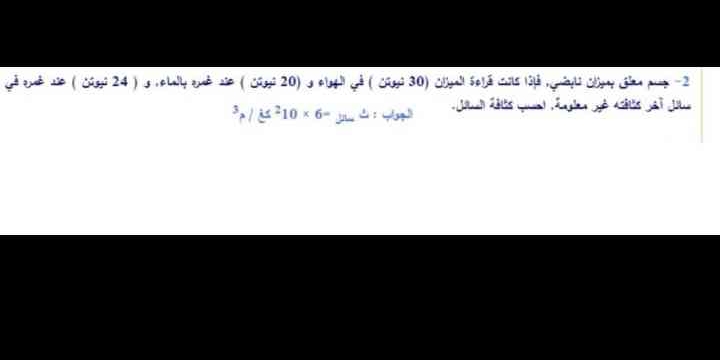جسم معلق بميزان نابضي، فإذا كانت قراءة الميزان (30 نيوتن) في الهواء و (20 نيوتن) عند غمره بالماء، و (24 نيوتن) عند غمره في سائل آخر كثافته غير معلومة. احسب كثافة السائل. جسم معلق بميزان نابضي، فإذا كانت قراءة الميزان (30 نيوتن) في الهواء و (20 نيوتن) عند غمره بالماء، و (24 نيوتن) عند غمره في سائل آخر كثافته غير معلومة. احسب كثافة السائل.

Understand the Problem
المطلوب هو حساب كثافة سائل غير معلوم، علما بأن جسما معلقا بميزان نابضي يعطي قراءات مختلفة للوزن في الهواء والماء وسائل آخر. سنستخدم قراءات الوزن هذه لمعرفة الفرق في قوة الطفو بين السوائل، ومن ثم حساب كثافة السائل المجهول.
Answer
$600 \frac{kg}{m^3}$
Answer for screen readers
$600 \frac{kg}{m^3}$
Steps to Solve
- Calculate the buoyant force in water
The buoyant force is the difference between the weight in air and the weight in water. $$F_{b,water} = W_{air} - W_{water} = 30 N - 20 N = 10 N$$
- Calculate the buoyant force in the unknown liquid
The buoyant force is the difference between the weight in air and the weight in the unknown liquid. $$F_{b,liquid} = W_{air} - W_{liquid} = 30 N - 24 N = 6 N$$
- Find the ratio of buoyant forces
The buoyant force is proportional to the density of the fluid. The ratio is the density of the unknown liquid over the density of water. $$ \frac{F_{b,liquid}}{F_{b,water}} = \frac{\rho_{liquid}}{\rho_{water}}$$
- Express the density of the unknown liquid
$$ \rho_{liquid} = \rho_{water} \cdot \frac{F_{b,liquid}}{F_{b,water}}$$
- Plug in the values
The density of water is approximately $1000 kg/m^3$. $$ \rho_{liquid} = 1000 \frac{kg}{m^3} \cdot \frac{6 N}{10 N} = 1000 \frac{kg}{m^3} \cdot 0.6 = 600 \frac{kg}{m^3}$$
$600 \frac{kg}{m^3}$
More Information
The density of the unknown liquid is 600 kg/m^3. This is less dense than water (1000 kg/m^3).
Tips
A common mistake is to forget to convert units or to use incorrect density values of water. Another common mistake is not correctly calculating the buoyant force by subtracting the weights.
AI-generated content may contain errors. Please verify critical information